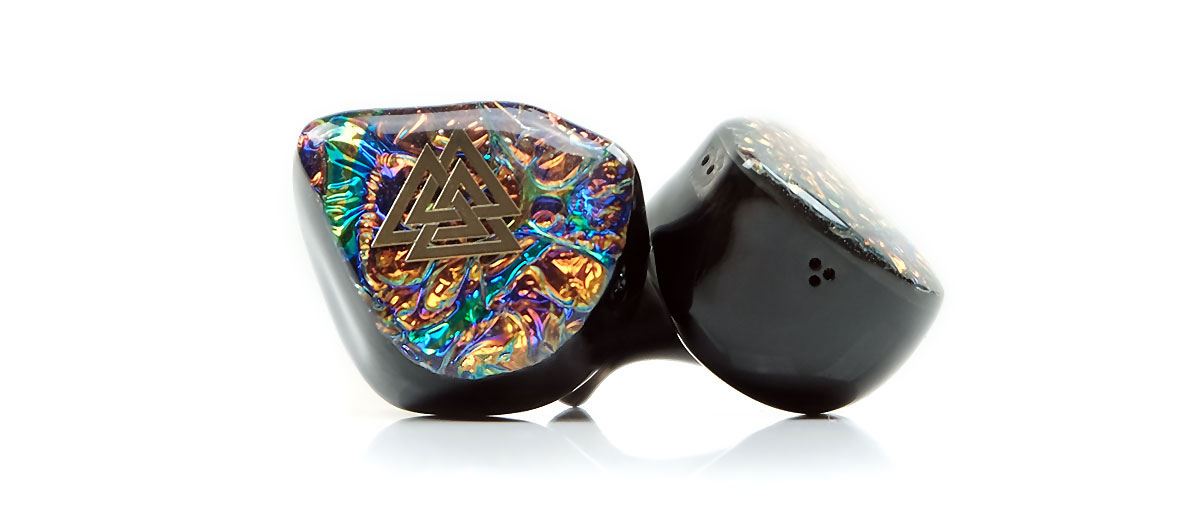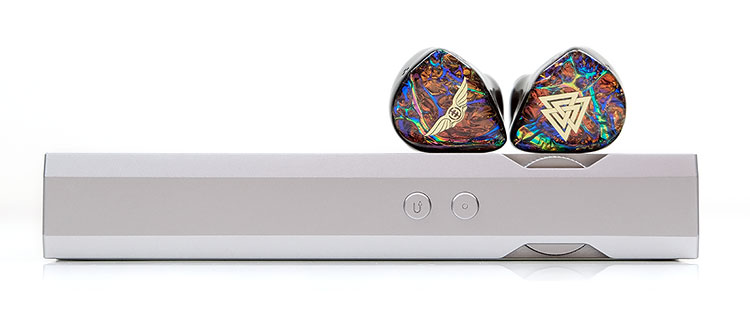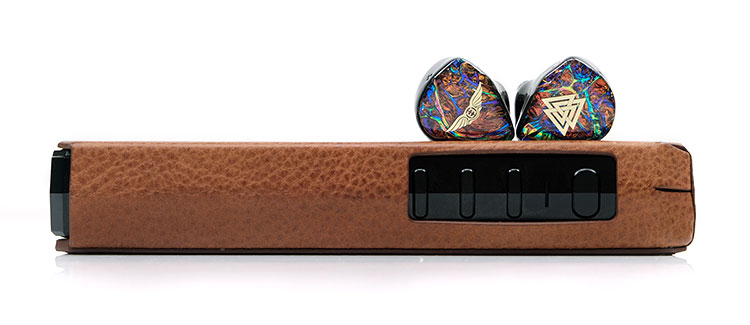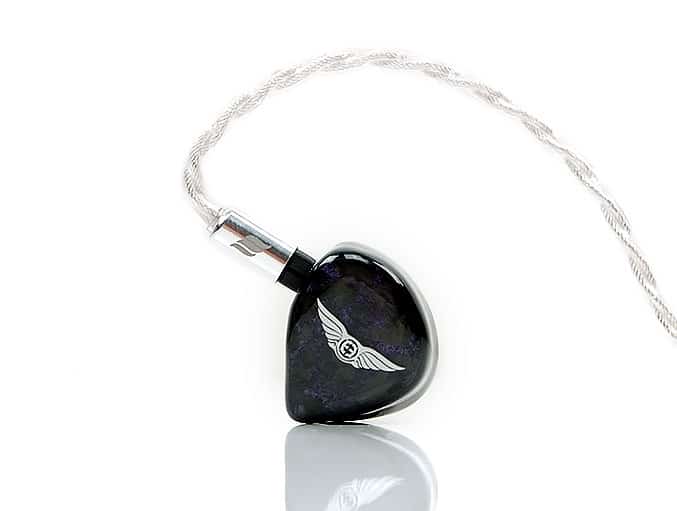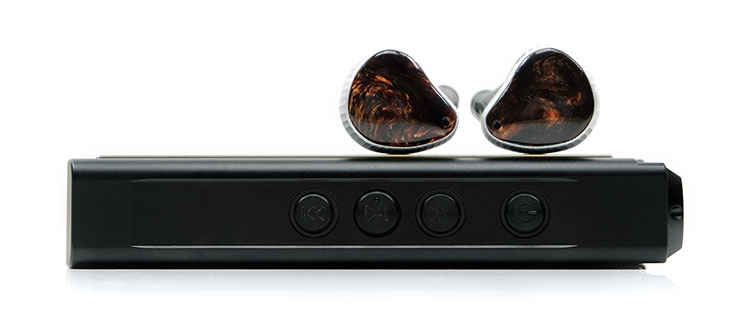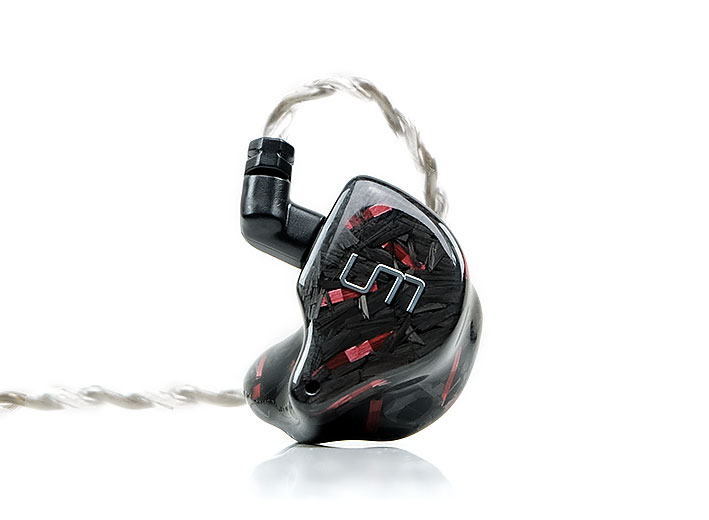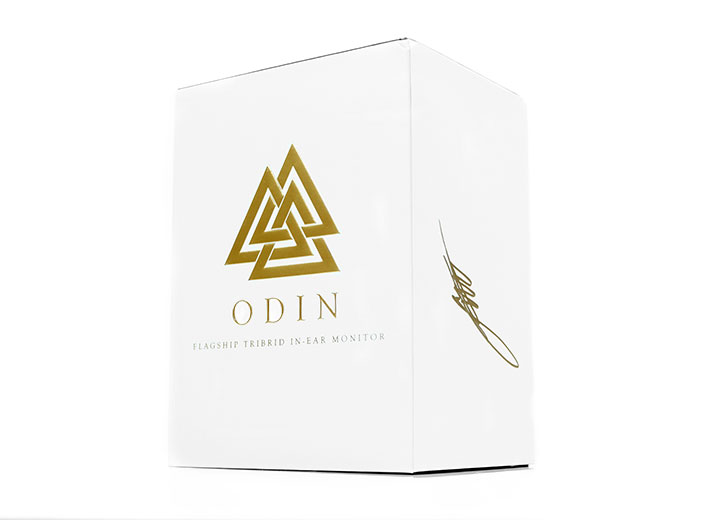Sound Impressions
Summary
The Odin is a monster of a monitor with world-class technical capability as well as an explosive and engaging tuning. It will appeal to both the detail freaks and those who want it loud and proud.
This is a performance that really does throw every aspect of their past thinking into one humble shell. We are talking a beautifully controlled but potent sub-bass response, a clean midrange with excellent separation and accurate vocals often to the fore.
It is also the company’s most mature electrostatic treble performance to date mixing a high-fidelity level of articulation with just the right amount of timbral brightness. You will enjoy the bass for sure on the Odin, but what really stands out for me is just how clear and precise that upper midrange and treble control is. It is a wonderful balancing act that Odin really nails.
On the FR side, the low-end is sub-bass biased over any mid-bass warmth with a steady drop even at 100Hz and well before the usual 500Hz lower-mids marker. From there is remains relatively linear to about 1k before a steep rise into the upper mids from 1-3k.
That rise delivers a very distinct and forward higher pitching vocal presence so if you are a vocal lover, like me, the Odin is going tickle your ivories like nothing else. And yet, it avoids sounding shouty or harsh with an evenly tuned treble response that is incredibly clear but also a few dB below that 3k peak right up to 8-9k.
That is an important tweak because it takes the sting out of the potential for vocals to sound sibilant or for percussion to dominate and push down on vocal clarity. You get the air, the separation but not the splashiness and heat of an over-excited BA driver.
Low-end Timbre
The Odin’s timbre can be on the cooler side of neutral but it is not a typical high-contrast lean sound. That slight tailing off on the treble in deference to the upper mids does make a palatable difference and switches the Odin from being potentially all ‘power and shimmer’ to something much more reference and accurate.
The low-end shaping contributes much to the slightly cooler nature of the Odin lower-range instrumental and male vocal timbre. That sub-bass tuning is incredibly potent but importantly, very controlled in terms of dynamic range. That means it hits hard when loud and stays quiet and nuanced when not required.
This is not a bloomy, dense, and omnipotent bass presence primarily due to the drop around 100Hz and dipped lower-mids right up to 1k. This keeps the warmth in check but also means instruments in this range lack a little girth, richness, or liquidity. That is a preference call because on the flipside the separation, clarity, and articulation from the lower-mids are outstanding.
And the power, oh my. The lowest fundamental on the Odin’s instrumental timbre is just fantastic. Combine that with the aforementioned dynamic range and control and it is a tailor-made tuning for that sparse but weighty modern R’n’B sound but at the same time really add some critical authority to double kick drums so critical to metal standards.
Vocal Timbre
Vocals are more mixed in terms of coloration. The lower-mids dips means male vocals are a little lighter in density and not as strong and forward sounding as higher pitching or standard female vocal ranges. I still feel the Sultan sets the standard here for density and presence for male vocals, particularly guttural metal chest voicing.
Any vocal that touches on that 1-3k rise will be forward but avoids sounding hard-edged or bright. That is where I think the Odin really excels. Here, vocal timbre is reference quality with slight wetness to the fore and a short decay to the rear to create an excellent sense of space and separation.
Again, much credit to Empire Ears for the treble response. If you are going to put female vocals front and center you have to avoid it pulling too much treble into its harmonic balance and I feel they have done exactly that here.
Even with stellar performers such as the recent Unique Melody MESH you get more sibilance compared to the Odin’s smoother delivery because of the enhanced treble 5-7k rise. The Odin does not work it as hard so vocals are way more natural and precise to my ear.
Staging
A very complex soundstage that goes big on depth but also a lower-mids tuning that allows for oodles of space. Despite the use of not one but 2 dynamic drivers on the low-end, EE has been very judicious with the quantity levels with the majority of it focused on extension rather than physical density.
That means you will get incredible levels of power but not a forward and suffocating level of warmth or bloom. I do tend to prefer that style of low-end tuning in hybrids. Yes, the separation is more extreme but the control just seems so much better.
That forward upper mids push a lot of vocals and some percussion further forward in terms of stage positioning which does contribute to that perception of a stretched and holographic staging quality. However, it is still not what I would call dense, more of that aforementioned high-fidelity quality with plenty of separation and space for vocals to breathe.
The imaging is stellar. You could nitpick on the lower-mids presence due to the dip but overall, the clarity is fantastic. The stereo left/right pan and scan is clean and fast and tremendously wide. A few times it actually caught me out as to just how wide it can be, almost like a reverse crosstalk filter at play.
One final note on staging height. The Odin has plenty of headroom but it is not a forced treble to create a false perception of treble extension or detail. In fact, the treble is relatively neutral in terms of presence and it has to be to get the synergy just right with those forward upper mids.
Synergy
Efficiency
The Odin is rated at a phenomenally low 3Ω which seems to be a running theme for the monitors we recently reviewed from them including the Valkyrie and Wraith which were both 4Ω configurations.
Impedance skew due to potential output mismatching, however, is thankfully absent and most likely due to the use of those dynamic drivers as opposed to pure BA which is where it can be more noticeable. Testing from a HiBy R6 Pro the Odin felt tonally correct in terms of sub-bass quantity and responsiveness and the treble performance was neither shrill nor dark.
AT 108dB SPL, the Odin is a little more current intensive than its stablemate, the Wraith (117dB SPL), despite both using a quad-electrostatic driver array. Again, the dynamic driver implementation is more of a factor here so the Odin juice levels will be a little higher than the Wraith and UM’s Mest but closer to the Noble Audio Sultan‘s volume levels.
Noise control is a minor factor in the Odin’s performance. It is nowhere near as sensitive as Campfire Audio creations or the hiss king form their own previous line-up, the Zeus. However, some DAPs will not yield a totally black background such as the Cayin N6ii with the E02 motherboard, the balanced output of the FiiO M15, and to a very marginal level the balanced output of the Sony 1Z.
However, it is super low in all reality and the vast majority of DAPs tested it was very quiet indeed including iBasso’s DX220 MAX, Lotoo PAW Gold Touch, the HiBy R8, Cayin’s N3Pro (all outputs), and the LP P6. This is not a monitor that will give you sensitivity issues.
Source Pairings
I think I must have tested 12 DAPs ranging from $499 to $4000 and to be honest the synergy with all of them was excellent. The only 2 I might hesitate on were older generation AK DAPs, the AK100 II, and the AK380/AMP combo where I felt the treble sounded a little on the rough side with the Odin pairing. Not quite as pure and smooth as I would like.
The DAPs I ended up using more often than not with the Odin were the ones with the best dynamic range and resolution as well as the blackest backgrounds. Timbre is less of an issue because I found the Odin to be quite transparent in that regard. The Odin will not mess with your source’s core sound which is a welcome bonus.
Dynamic range is vitally important with the Odin. You need that bass to remain explosive, yet tight and properly defined. The last thing you want is a compressed presentation with poor separation from the Odin or the bottom falling away. To that end, the likes of the iBasso DX220 MAX, Luxury & Precision’s P6, and the Lotoo PAW Gold Touch took top honors for pairing with the Odin.
All three were very quiet for noise, with the MAX being the most expansive and the P6 offering the densest timbre of the three. The Touch lay somewhere in between those two with perhaps a bit more treble shine.
Just behind them was the HiBy R8. This was smoother sound, very expansive also but slightly politer in its delivery but with hellish juicy mids. Compared to the R6 Pro performance the vocals were much more vivid and engaging on the R8 when paired with the Odin.
Select Comparisons
Empire Ears Wraith
$3499
Technical
The Wraith is the current flagship of EE’s EP series which is more or less the company’s pure armature driver line-up with the Phantom tucked in just behind it. Both the Odin and the Wraith are universal monitors and they do share some similar in-house tech features including A.R.C., EIVEC, and a synX Crossover network.
The configuration is very different. The Odin uses 3 varieties of drivers including a dual Weapon IX+ dynamic driver setup for the low-end, 5 BA for the mids, and 4 electrostatic drivers for the highs.
The Wraith also uses 4 electrostatic drivers for the highs and super highs but compliments it with a pure BA setup below that with no less than 7 BA drivers: 2 BA for the lows, 3 for the mids, 2 for the highs, and the quad e-stats for the super highs.
Both have a light and breezy rating on paper with the Wraith coming in at just 4Ω and 117dB SPL and the Odin even lower at 3Ω but requiring more current with a lower 108dB SPL (weighted). Basically, the Odin will run the volume on your source a few notches higher but otherwise not hard to drive.
Design
Very similar build with both using an acrylic opaque onyx acrylic shell and a slightly contoured form factor for a comfortable fitting. The big difference is the faceplate with the dazzling ‘pop’ of the dragonhide plate on the Odin and the more nuanced Amethyst Haze of the Wraith. One is a virtual rainbow collage of colors and the other a subtle swirl of purples and black.
One thing that I did not expect was the weight of the Wraith which was slightly more than the Odin despite the Odin also using 11 drivers with two of them being dynamic. It is a tiny gap but somewhat noticeable in the hand.
Also, the size of the Wraith is marginally bigger and taller and sticks out of your ear slightly more. Both have the exact same comfort levels with the same Final E tip range but the Wraith isolates better as it does not need those dynamic driver vents being an all BA build.
Both also use top-quality aftermarket cables with the Effect Audio 26AWG pure silver Cleopatra for the Wraith and the new Stormbreaker multi-gauge 24AWG and 26AWG OCC Copper Litz design via PW Audio and Pentaconn for the Odin.
Tuning
Aside from both having a noticeable drift north in the upper mids, these two monitors sound incredibly different from each other.
Bass
On the low-end, the Odin opts for weight, power, and that classic dynamic driver timbre with excellent texture, a slightly slower pace, and longer decay.
The Wraith is much more neutral with a BA timbre that is perceptibly faster, a little cleaner but a lot lighter. Though it does have a mild bump for warmth and presence it is more supportive for instrumental fundamentals and injecting a bit of warmth in its midrange timbre.
The Odin’s low-end is even more impressive because that power does not come with unwelcome bloom with a fairly early drop into the lower-mids from almost the 100Hz marker. The control is excellent for a couple of dynamic drivers in tandem. The Wraith low-end drops a bit later around 200-300Hz and only by a few dB into the lower-mids so overall a softer response.
Mids
As a result, the lower-mids on the Wraith carries a bit more presence and a more even-harmonic rounded timbre. The Odin’s more prolonged dip keeps it cleaner and cooler relying on a bit more contrast from the upper mids and treble performance to balance out the power of the Weapon XI+ drivers. Vivid versus smooth basically.
Both have a pushed 2k marker though for the Odin that rise starts 1k and continues a bit longer up to 3-4k. The Wraith, to borrow a PMEQ term, has a narrower Q factor with a rise and drop from 1-3k and less lower-treble presence.
The Wraith will sound a bit smoother through those mids with more warmth and less odd-harmonic contrast. Comparatively, it lacks a little top-end air compared to the Odin but with a fuller mids sound that tends to suit that Les Paul tube amp tone a bit better. The Odin shoots for technical excellence in the mids, sounding more articulate and complex in its instrumental placement.
Treble
No question the Odin has the stronger treble presence with more of a 5-7k lift and less fade post 8k. It is an excellent treble but a needed one to keep everything properly balanced due to the power of the low-end. As a consequence, it is the airier and more extended sounding of the two flagships.
The Wraith has more of a treble fade so it can sound liquid and sweeter sounding, less fatiguing overall but at the same time not ideal for high energy percussion mixes which is where the Odin delivers a lot more excitement and bite.
Noble Audio Sultan
$2900
Technical
The Sultan is Noble Audio’s latest flagship universal monitor and like the Odin, it is a blend of 3 different driver types. The Sultan is a 7 driver design consisting of a single 10mm dynamic driver for the lows, for the lows and 4 BA drivers for the mids and 2 Sonion electrostatic drivers for the highs and ultra-highs.
The Odin has a higher driver count at 11 with 2 Weapon IX+ dynamic for the lows, 5 BA for the mids, and a quad-electrostatic array for the highs and super highs using that complex 8-way synX crossover.
Noble keep their exact driver composition and crossover technology under wraps but they do refer to this as a 3-way monitor so we assume there is no electrical crossover quite like the 8-way synX crossover network from Empire Ears.
The exact ratings are also a bit of guess for the Sultan but we do know from our review that it is one of the more sensitive ones to current with a less demanding performance than something like the Khan. Compared to the Odin the difference is marginal at best with both comfortable at similar volume levels using a low-gain setting on both the iBasso DX220 MAX and HiBy R8.
Design
Quite different design approaches from the two companies but both are incredibly attractive universal monitor designs with some unique touches.
The Sultan is long rather than an overly large monitor consisting of three parts, main shell, faceplate holder, and faceplate. The faceplate is adorned with a stunning hand-finished aura or Galaxy swirl type amber facade. The black shells are cut from a single aluminum block with a ribbed outer texture and separated from the plate via a silvery band with a similar ribbed finish.
The Odin is all acrylic, smaller, and lighter but perhaps not as durable as the aluminum body of the Sultan. The nozzle is shorter but it does not need to be that long as the main body does get a lot closer into the concha basin. The Sultan relies on a longer nozzle to go deep with the majority of the body sitting a few mm above the concha basin.
Both have a decent set of tips selectable with the Sultan having the widest variety of foams and single bore silicone but the Odin’s use of the Final E is a step up on the stock silicone tips of the Sultan in terms of isolation and performance. Isolation on both is fairly similar due to the dynamic driver venting required by both but the Odin is the comfier and lighter of the two in the ear.
Both have good cables but to be honest, the Stormbreaker 4-wire OCC copper Litz is a very high-quality lightweight cable and retails 6 times as much as the 26AWG 1.2m 8-core OCC copper wire included with the Sultan. 8-wire always does very well in terms of dynamic range, however, so the gap is not huge but physically it is a much bigger and heavier construct.
Tuning
These two are incredibly competitive to each other and I suspect your choice might come down to personal preference. Both offer a weighted low-end, forward vocal, and a good electrostatic treble presence but the way those dominant curves points have been teased out means the timbre is actually relatively different to me.
On top of that, there is a difference in some of the technical capability of the two in terms of instrumental separation but more towards the top end where the Odin sounds airier, more articulate, and precise in its delivery. It could well be 4 e-stats drivers trumps 2, or that 5 BA mids out-details 4 or simply the intended tuning goal of each company is different.
Bass
On the low-end, the major deviation is that dip from mid-bass into the low-mids which happens earlier on the Odin. That means both are super-solid below 100Hz with perhaps the Odin showing off a bit more control and a better dynamic range.
The Sultan dynamic driver extends a bit more into the mid-bass with a denser and warmer sound. The transition from bass to mids on the Sultan is really smooth. That density and warmth will make the Sultan a better fit for hard rock stuff where you want a liquid rich bass guitar tone and plenty of crunch to your rhythm guitar chords.
Mids
The Odin’s faster and more prolonged dip into the lower-mids means you get a cleaner lighter timbre for the aforementioned instruments. Bass to mids separation is also more noticeable but it does help to create a more spacious low-end. The Odin bass to lower-mids performance also sounds a bit more articulate, not as intimate, yet still with the same kicking bass fundamental overtone.
Vocals
Vocals are also quite different on both monitors with the Sultan doing better with lower-pitching male vocals and the Odin really hitting a home run with female vocals, particularly ethereal voicing.
The Sultan male vocal benefits from that density and warmth from the low-end plus what seems to be an earlier lower-mids to a 1-2k peak that gives it a bit more physicality and presence. The Odin is a cleaner but slightly leaner for male vocals and not quite as forward.
The Odin, on the other hand, is very precise and beautifully defined with vocals that straddle that 2-3k region where it is most prominent. The Sultan seems not quite as forward or perhaps not as much air creeping in with less instrument/vocal separation. It is still a bit more full-bodied but not as well defined or as forward.
Treble
The Sultan has the more energetic 5-7k treble region but the Odin seems to have slightly better separation and shorter decay. That, in turn, creates an airier or taller soundstage despite having slightly less emphasis.
I suspect the upper treble on the Sultan has been faded a little because my ear is drawn more to the fuller sounding percussion timbre and you normally do not get that full sound if the upper treble has more emphasis than the lower-treble.
With the Odin, that greater upper mids elevation does catch a bit more upper order harmonics energy from its treble. The timbre is more neutral compared to the Sultan and a shade less body for percussion also. You could call it more of a precise high-fidelity approach compared to the treble tuning of the Odin.
Unique Melody MEST
$1699 (Custom version)
Technical
Yes, it is a lot cheaper, however, in our review recently I felt the MEST performed well above its price point and used some very unique technology. It could well be the ‘high-end bang for buck’ if such a thing exists. This is the custom version rather than the universal so we will not go into too much in terms of design commentary.
The MEST is a ‘quad-brid’, not a hybrid or a ‘tribrid’. It uses a blend of 4 different types of drivers: dynamic, BA, electrostatic, and bone conduction. The Odin uses 3 types, dynamic, BA, and electrostatic.
The precise configuration of the MEST is also relatively complex. You get a single 10mm dynamic driver for the lows, 2 BA for the mids and upper mids, 2 BA for the highs, and 2 Sonion electrostatic drivers for the ultra-highs. The bone conduction driver adds an additional layer across the mids and highs.
The Odin is more complex on the low-end with 2 Weapon IX+ dynamic drivers, then 5 BA for the mids, and 4 electrostatic drivers for the highs. It uses an 8-way synX crossover network compared to MEST’s 5-way crossover network.
The MEST is rated at 14Ω and 118dB compared to the Odin’s slightly more current demanding 3Ω and 108dB. Neither needs anything other than a good DAP in a low-gain setting, voltage is not an issue here but the electrostatic drivers do tend to push up the volume requirements.
Design
One is custom and one is universal so very different properties with the MEST obviously sealing and fitting the better of the two due to its exact fit. Both do have bass venting ports but the MEST’s loss of isolation due to that port is much less compared to the universal Odin.
With the Odin, you can tweak the sound via the tips if you happen to have 3rd party but it is otherwise very comfortable and light fitting universal IEM.
The two have some excellent designs and as stated, I would love to see a 100% custom dragonhide Odin, I think that would be top dog. The MEST goes the extra mile also with tie carbon fiber Dreamweaver shells creating a very striking aesthetic.
One thing to note, the protruding 2-pin connectors on the MEST. I tend to prefer the regular flush or recessed 2-pin 0.78mm sockets on the Odin. I get the convex socket design is sturdier but it is a right pain to roll cables with the MEST as the connection with regular 2-pin is that much weaker.
One final note on the cables, the dual-gauge OCC Copper Litz Stormbreaker is way more premium in both price and finish even though it is a 4-wire compared to the 8-wire 6N SPC translucent jacketed stock cable included with the MEST.
8-wire usually does have significantly better dynamic range but the Stormbreaker’s mixed AWG (24 and 26), reduces that gap to nothing and is the more revealing of the two cables.
Tuning
The MEST has some differences but it is still hard to believe how cheap this monitor is for the performance. I think it slots in just behind the Odin in terms of technical capability and it does have a different timbre that creates a reasonably clear distinction between the two. So no, the MEST is not an Odin light in that regard but it a more wallet-friendly alternative.
On the low-end, the Odin has more power, more lift in its sub-bass tuning, and sounds the deeper of the two. You want the Odin if you need a more gut-wrenching bass fundamental to kick drums and bass synth beats. The MEST also has a sub-bass bias over mid-bass warmth but it is not as extended or as powerful, there seems to be slightly less quantity and not quite as tight.
Both drop fairly early around 100Hz but the cut into the upper bass and lower-mids is deeper on the Odin whereas the MEST starts to rise around 700-800Hz and keeps on trucking until around 3k where it starts to lose a bit of energy.
You will not get bass bleed with the MEST but the instrumental and male vocal warmth and presence are more prominent on the MEST. It is a beautifully smooth transition in all fairness. The Odin’s flatter response curve through to 1k delivers less warmth and instrumental presence even though it has the better instrumental bass fundamental.
Female Vocals
Female vocals on the Odin are further forward with that entire 2-4k range much further forward compared to the MEST gentler rise to 3k. The MEST actually has a little dip from 3-4k for me which pushes down vocal presence marginally in comparison.
Here is the interesting thing though despite Odin’s more forward upper mids, the treble is under better control and thus sibilance is less prevalent on vocals compared to the MEST.
That is because the MEST treble actually has more of a 5-8k lift compared to the Odin. That lift is picked up as a stronger upper-order harmonic in its vocal and percussion timbre which gives it a sharper attack and enhanced sibilance.
The Odin does not do that. Sure, it is vibrant and forward but at the same time, it does not have any cautionary sharp sounding partial overtones. Perhaps that is why the MEST’s 3-4k upper mids dip is there just to reduce the potential sting.
Our Verdict
The Odin is a technical beast bar none with masterful levels of control from the dual subwoofer configuration right up to that nuanced treble tuning. Nothing is overdone, even those forward upper mids are beautifully tempered by a coherent treble tuning.
Sure, it is gripping, it is vivid and not something I could call terribly relaxed in its delivery. Yet, it avoids the pitfalls of ‘exciting tuning’ by laying off high-contrast parlor tricks that can often steer your ear down the fatiguing direction for all the wrong reasons.
What else could I wish for? Well, I can only imagine how amazing the Odin would be in a custom all-dragonhide design. Best universal I have reviewed in 2020 overall, possibly, but one wonders if a custom version could well be the perfect icing on an already tasty cake.
Empire Ears Odin Specifications
- 11 Proprietary Drivers, Tribrid Design
- 2 Next Generation W9+ Subwoofers – Sub-Bass, Bass
- 5 Proprietary Balanced Armature Drivers – 2 Low-Mid, 2 Mid, 1 Mid-High
- 4 Premium Electrostatic Drivers – 2 High, 2 Super-High
- 7-Way synX Crossover Network
- EIVEC – Empire Intelligent Variable Electrostatic Control Technology
- A.R.C. Resonance Mitigation Technology
- Impedance: 3 Ohms @ 1kHz
- Frequency Response: 5 Hz – 100kHz
- Sensitivity: 108dB @ 1kHz, 1mW
- Bespoke Stormbreaker UPOCC Copper Litz Cable, Quad Conductor Dual Guage Design

